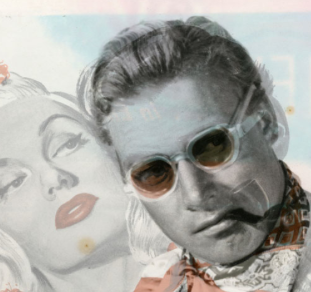Last Updated on December 5, 2012, 3:00 pm ET
When museum curator Sky Lacerte saw a conference session about how some archives use photo overlays to show how landscapes and buildings have changed over time, she was inspired to try a twist on that idea at her own library, the Modern Graphic History Library at Washington University in St. Louis. Using digital technology, Lacerte could show how mid-century illustrator Al Parker took his own photographs to use as the basis for realistic illustrations, and then how those illustrations were used by the magazine stories that incorporated his work.
The library was confident they had the rights they needed to display Parker’s original works on the web. The final magazine pages, however, were another story. Taken from publications like Ladies’ Home Journal and Good Housekeeping, the copyright in the pages was probably owned by the magazine publisher (or whatever corporate parent had since acquired it), and getting permission could be difficult, impossible, and in any case needlessly expensive. And without the final image showing the illustration in context, the story would be incomplete. The project was put on hold pending a settlement of the copyright issue.
Luckily, Lacerte was able to collaborate with her library’s Copyright Coordinator, who was aware of the Code of Best Practices in Fair Use for Academic and Research Libraries, to design the exhibit in a way that reflected her community’s consensus around fair use. The resulting exhibit, Double Exposure: Al Parker’s Illustrations, from Model to Magazine, tells the full story of how a mid-century illustrator used staged photography as an essential step in his creative process.

A quick look at the exhibit makes it easy to see how Lacerte applied Principle Two of the #librarianscode, which describes how to use copyrighted works fairly in the creation and support of exhibits, both physical and virtual. The exhibit fits the description of Principle Two perfectly: it is an exhibit to publicize the library’s excellent collection of illustrations and photographs, and to generate knowledge and interest around the collection. It includes full attribution so that viewers can determine the provenance of the original magazine images. The images were carefully chosen and displayed at a level of resolution appropriate to the illustrative purpose, i.e., the magazine images are clear and crisp enough to convey the important connection to the original photographs and illustrations, but not so crisp or complete that they can be useful for other, non-transformative purposes (such as reading the associated magazine articles). Lacerte used technological measures to prevent downloading of the images, further enhancing her fair use case. The curation of the exhibit is obvious, as is the appropriate contact person for anyone interested in expressing concern over the exhibit. All in all, it’s a powerful fair use, and the kind of project that might easily have been scrapped or delayed indefinitely without support from a community consensus document like the Code.
This is the third blog post in a series highlighting some of the fair use success stories we’re beginning to hear from librarians using the Code to move past fear and uncertainty and into positive action using their fair use rights. As with every Code of Best Practices, the #librarianscode can, will, and should be applied differently by different people and institutions in different situations. It is not one-size-fits-all. Some will be more conservative than the consensus described in the Code, while others may go further, depending on local circumstances. These stories are not meant to highlight ideal or best applications of the Code, as there is really no single right way to use the document. Rather, these stories show libraries moving from inaction to action thanks to the encouragement and support that the Code provides. How will you use the Code? If you have a story to share, please email socialmedia@american.edu.



